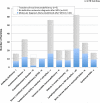Primary immunodeficiency diseases: Genomic approaches delineate heterogeneous Mendelian disorders
- PMID: 27577878
- PMCID: PMC5222743
- DOI: 10.1016/j.jaci.2016.05.042
Primary immunodeficiency diseases: Genomic approaches delineate heterogeneous Mendelian disorders
Erratum in
-
Corrigendum.J Allergy Clin Immunol. 2018 Feb;141(2):832. doi: 10.1016/j.jaci.2017.12.975. J Allergy Clin Immunol. 2018. PMID: 29413258 No abstract available.
Abstract
Background: Primary immunodeficiency diseases (PIDDs) are clinically and genetically heterogeneous disorders thus far associated with mutations in more than 300 genes. The clinical phenotypes derived from distinct genotypes can overlap. Genetic etiology can be a prognostic indicator of disease severity and can influence treatment decisions.
Objective: We sought to investigate the ability of whole-exome screening methods to detect disease-causing variants in patients with PIDDs.
Methods: Patients with PIDDs from 278 families from 22 countries were investigated by using whole-exome sequencing. Computational copy number variant (CNV) prediction pipelines and an exome-tiling chromosomal microarray were also applied to identify intragenic CNVs. Analytic approaches initially focused on 475 known or candidate PIDD genes but were nonexclusive and further tailored based on clinical data, family history, and immunophenotyping.
Results: A likely molecular diagnosis was achieved in 110 (40%) unrelated probands. Clinical diagnosis was revised in about half (60/110) and management was directly altered in nearly a quarter (26/110) of families based on molecular findings. Twelve PIDD-causing CNVs were detected, including 7 smaller than 30 Kb that would not have been detected with conventional diagnostic CNV arrays.
Conclusion: This high-throughput genomic approach enabled detection of disease-related variants in unexpected genes; permitted detection of low-grade constitutional, somatic, and revertant mosaicism; and provided evidence of a mutational burden in mixed PIDD immunophenotypes.
Keywords: Primary immunodeficiency disease; copy number variants; whole-exome sequencing.
Copyright © 2016 American Academy of Allergy, Asthma & Immunology. Published by Elsevier Inc. All rights reserved.
Figures





References
-
- Picard C, Al-Herz W, Bousfiha A, Casanova JL, Chatila T, Conley ME, et al. Primary Immunodeficiency Diseases: an Update on the Classification from the International Union of Immunological Societies Expert Committee for Primary Immunodeficiency 2015. Journal of clinical immunology. 2015 Oct 19; PubMed PMID: 26482257. - PMC - PubMed
-
- Stray-Pedersen A, Abrahamsen TG, Froland SS. Primary immunodeficiency diseases in Norway. Journal of clinical immunology. 2000 Nov;20(6):477–85. PubMed PMID: 11202238. - PubMed
-
- Al-Herz W, Zainal ME, Alenezi HM, Husain K, Alshemmari SH. Performance status and deaths among children registered in Kuwait National Primary Immunodeficiency Disorders Registry. Asian Pac J Allergy. 2010 Jun-Sep;28(2-3):141–6. PubMed PMID: WOS:000283405200007. English. - PubMed
-
- Gathmann B, Mahlaoui N, Ceredih, Gerard L, Oksenhendler E, Warnatz K, et al. Clinical picture and treatment of 2212 patients with common variable immunodeficiency. The Journal of allergy and clinical immunology. 2014 Jul;134(1):116–26. PubMed PMID: 24582312. - PubMed
-
- de Pagter AP, Bredius RG, Kuijpers TW, Tramper J, van der Burg M, van Montfrans J, et al. Overview of 15-year severe combined immunodeficiency in the Netherlands: towards newborn blood spot screening. European journal of pediatrics. 2015 Sep;174(9):1183–8. PubMed PMID: 25875249. Pubmed Central PMCID: 4539359. - PMC - PubMed
Publication types
MeSH terms
Grants and funding
LinkOut - more resources
Full Text Sources
Other Literature Sources

